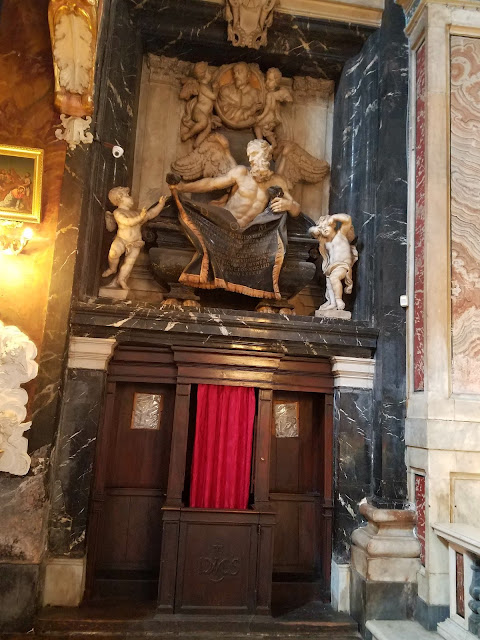Continuing the series, the next post detailing my pilgrimage to Rome will showcase the beauty of the four major Basilicas: St. Peter's Basilica, St. Mary Major, St. John Lateran, and St. Paul Outside the Walls. Each of these treasures of Christendom are massive and contain some of the most precious objects in Christianity. To walk through the Holy Doors of each of these basilicas was a tremendous honor and privilege that I will never forget.
St. Peter's Basilica (Vatican)
St. Peter's Basilica is the largest and grandest Church in the entire world. Besides its massive size (i.e. the altar is 2 football fields away from the entrance of the door), it is full of some of the most precious items in the world. I was able to visit the Tomb of St. Peter and the Popes, see the body of St. Pius X and several other saints, venerate the statue of St. Peter, and visit the 7 altars in St. Peter's (which is attached to an older indulgence and tradition in the Raccolta). The famous Pieta is also here. This church is something that everyone must see in their lifetime. It is truly a wonder of the world.
St. Mary Major
Inside St. Mary Major are several relics - the most important of which is the Crib in which our Lord Jesus Christ was born. This most holy of items is preserved in a reliquary and housed under the altar for veneration. The 2nd photo below is the holy door (Porta Sancta).
St. John Lateran
St. John Lateran might have been my favorite of the basilicas. It featured awe-inspiring statues of the 12 Apostles with some of the most beautiful artwork and details I had ever seen. It was the first of the four basilicas that I visited.
After visiting on Palm Sunday, I walked across the street and took part in the time-honored custom of walking up the holy stairs. The Holy Stairs are the same stairs that Jesus ascended before His Passion. They were brought to Rome and for a time, the chapel there at the top of the stairs (called the Sancta Sanctorum) contained some of the most holy relics in the world. The chapel there was considered up until then the most holy place in the world. Today those who ascend the Holy Stairs must still ascend only on their knees in prayer and penance, and in so doing, an indulgence may be gained.
St. Paul Outside the Walls
As the name denotes, the Basilica of St. Paul Outside the Walls is further from the center of the city and more difficult to reach than the other basilicas. However, it is still easily accessible off of the public transit's train route. Inside the basilica is preserved the chains that housed St. Paul. This basilica, built on the spot of his martyrdom is a testimony of the power of God to convert anyone - even people like Saul who persecuted Christians.
Read more >>
St. Peter's Basilica (Vatican)
St. Peter's Basilica is the largest and grandest Church in the entire world. Besides its massive size (i.e. the altar is 2 football fields away from the entrance of the door), it is full of some of the most precious items in the world. I was able to visit the Tomb of St. Peter and the Popes, see the body of St. Pius X and several other saints, venerate the statue of St. Peter, and visit the 7 altars in St. Peter's (which is attached to an older indulgence and tradition in the Raccolta). The famous Pieta is also here. This church is something that everyone must see in their lifetime. It is truly a wonder of the world.
St. Mary Major
Inside St. Mary Major are several relics - the most important of which is the Crib in which our Lord Jesus Christ was born. This most holy of items is preserved in a reliquary and housed under the altar for veneration. The 2nd photo below is the holy door (Porta Sancta).
St. John Lateran
St. John Lateran might have been my favorite of the basilicas. It featured awe-inspiring statues of the 12 Apostles with some of the most beautiful artwork and details I had ever seen. It was the first of the four basilicas that I visited.
After visiting on Palm Sunday, I walked across the street and took part in the time-honored custom of walking up the holy stairs. The Holy Stairs are the same stairs that Jesus ascended before His Passion. They were brought to Rome and for a time, the chapel there at the top of the stairs (called the Sancta Sanctorum) contained some of the most holy relics in the world. The chapel there was considered up until then the most holy place in the world. Today those who ascend the Holy Stairs must still ascend only on their knees in prayer and penance, and in so doing, an indulgence may be gained.
St. Paul Outside the Walls
As the name denotes, the Basilica of St. Paul Outside the Walls is further from the center of the city and more difficult to reach than the other basilicas. However, it is still easily accessible off of the public transit's train route. Inside the basilica is preserved the chains that housed St. Paul. This basilica, built on the spot of his martyrdom is a testimony of the power of God to convert anyone - even people like Saul who persecuted Christians.

























































